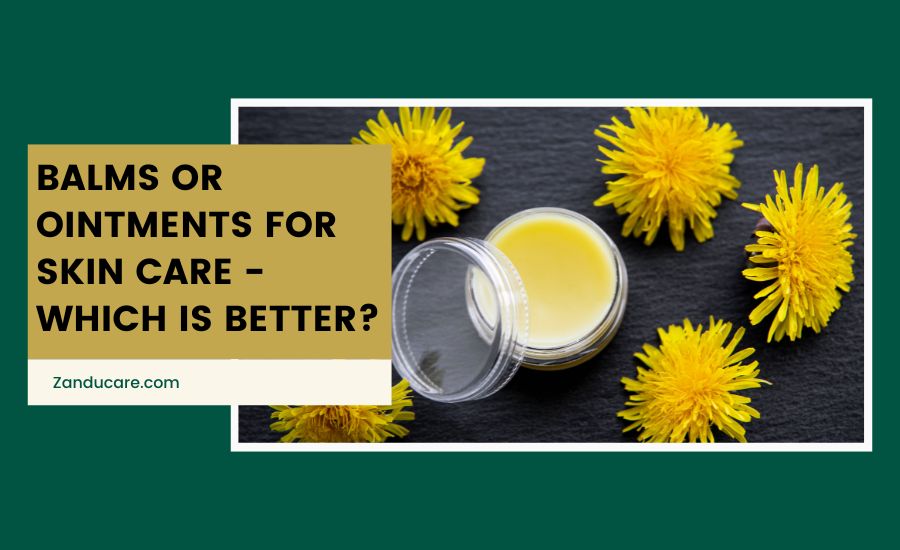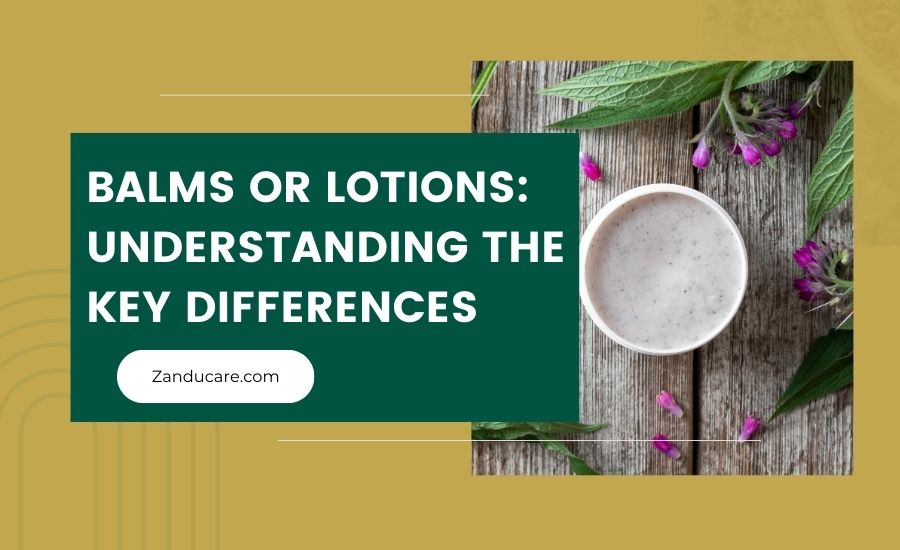
Balms Vs Ointments: Which is Best for Skin Care?
Key insights:
- Balms are oil-based and contain natural waxes like beeswax, which help to lock in moisture. They often include ingredients like shea butter, essential oils, and herbs.
- Ointments, however, are thicker and greasier, with a petroleum or lanolin base, making them more occlusive for skin protection.
- Balms have a solid, waxy texture that softens when applied, absorbing quickly without leaving a greasy feel. Ointments are heavier, slow to absorb, and create a protective barrier on the skin, which is ideal for sealing in moisture over extended periods.
- Balms are great for targeted hydration on lips, elbows, and cuticles. They’re ideal for small, dry patches needing quick relief. Ointments are best for larger, severely dry or cracked areas (like hands and feet) and are often used to treat conditions like eczema or to heal minor wounds.
- Balms suit people with combination or oily skin due to their lighter feel. Ointments, being more intensive, work well for very dry, sensitive, or irritated skin, providing long-lasting hydration and protection.
- Balms are popular for natural skincare routines due to their minimal, often organic ingredients. Ointments, such as antibiotic, antifungal, or corticosteroid ointments, are frequently used in medical treatments due to their stronger barrier properties and ability to protect and heal.
Balms and ointments are both topical preparations used to treat various skin conditions. They have a similar thick, buttery texture and are meant to moisturise, soothe, protect and relieve skin irritation. However, some key differences between balms and ointments in terms of their formulation, uses, and effects are important to understand when selecting one for skin care. So, to know the differences, read on to:
|
Did you know:
|
Difference Between Balms and Ointments
|
Feature |
Balms |
Ointments |
|
Texture |
Waxy, solid texture that becomes soft when warmed, ideal for spot treatments |
Thick, greasy texture, often softer or semi-solid, designed to cover larger areas |
|
Main Ingredients |
Natural ingredients like beeswax, shea butter, cocoa butter, and essential oils |
Higher concentrations of oils like petrolatum, mineral oil, or lanolin |
|
Absorption Rate |
Absorbs quickly with a non-greasy feel, especially suitable for humid climates |
Slow absorption; leaves a protective layer on the skin, ideal for intense moisture retention |
|
Purpose |
Targeted hydration for specific areas (e.g., lips, elbows, knees), often used for mild dryness |
Deep hydration and protection for dry, cracked, or damaged skin, often used in medical treatments |
|
Application Areas |
Ideal for small areas that need quick, soothing hydration (lips, cuticles, minor dry patches) |
Best for large areas needing moisture retention, like hands, feet, or eczema-prone areas |
|
Barrier Properties |
Forms a light barrier without sealing the skin, allowing it to breathe |
Forms a stronger barrier, locking in moisture to promote healing and protect from irritants |
|
Skin Types |
Suitable for combination, oily, and normal skin types |
Ideal for very dry, sensitive, or damaged skin needing intensive hydration |
|
Common Uses |
Natural skincare routines, minor dry patches, quick touch-ups |
Medical use for skin protection, wound healing, severe dryness, and irritation protection |
What is a Balm?

A balm is an oil-based preparation used to moisturise and treat skin conditions. It has a waxy, thick consistency and often contains beeswax or plant-based waxes that give it structure while also sealing in moisture. Common ingredients in balms include oils like coconut oil, shea butter, essential oils, and extracts from herbs or flowers that provide various benefits for the skin.
Some examples of balms used for skin care include:
- Lip balms: Contain waxes, oils and butter to seal in moisture and prevent chapped lips
- Body balms: Deeply moisturise and nourish dry skin anywhere on the body
- Cuticle balms: Soften the cuticles and condition the nails
- Healing balms: Can help minor cuts, burns or abrasions using antibacterial, anti-inflammatory ingredients
What is an Ointment?

Ointments are also topical preparations but have a different formulation than balms. The base of an ointment is either petroleum jelly, lanolin, or stearates, which gives it a thicker, greasier texture than balms.
Some common ointments used for skin care treatment include:
- Antibiotic ointments: Used to prevent infections in minor cuts and burns.
- Antifungal ointments: Treat fungal skin infections like athlete’s foot or ringworm
- Corticosteroid ointments: Reduce inflammation and itching from rashes, eczema or allergic reactions
- Protectant ointments: Form protective barriers on skin exposed to moisture or friction
Key Benefits of Balms & Ointments for Skin Care

Balm
Balms offer a variety of benefits for those looking to target specific areas with a blend of natural ingredients. Here’s how they can support your skin:
1. Healing Properties
Balms are often packed with natural oils and butter that nourish dry, cracked, or damaged skin. The oils penetrate the skin, helping it repair and rebuild while reducing inflammation. For example, a balm with calendula oil can be incredibly soothing on minor cuts or dry patches, helping to accelerate the healing process.
2. Best for Targeted Application
Balms' compact, wax-based formula makes them ideal for application in areas like elbows, knees, cuticles, and lips. Unlike creams or lotions, balms stay where you apply them without melting or dripping. They’re perfect for treating smaller, localised areas that require extra attention.
3. Natural Ingredients Appeal
Many skincare enthusiasts appreciate that balms are often formulated with minimal and natural ingredients, making them suitable for individuals sensitive to chemicals or fragrances. Balms are especially popular among those seeking 'clean' skincare, as they typically avoid synthetic additives, opting instead for oils and botanical extracts that benefit the skin naturally.
4. Non-Greasy, Lightweight Feel
Balms are lighter than ointments, absorbing well without leaving a heavy, greasy layer on the skin. This makes them an excellent option for those who want deep hydration without the heaviness of an ointment, especially in humid climates.
Ointments
Ointments are often recommended for those with more intensive skin care needs, particularly in severely dry skin, eczema, or wounds. Here’s why ointments can be an excellent choice for deep hydration and healing:
1. Intensive Moisturisation
Due to their high oil content, ointments are excellent for sealing moisture into the skin, providing a protective barrier that can help prevent moisture loss. This is particularly helpful in dry climates or winter when skin loses hydration quickly.
2. Barrier Formation
Ointments create a barrier over the skin, which is especially beneficial for those with sensitive skin or conditions like eczema. This barrier helps protect the skin from irritants, bacteria, and allergens, giving the skin a chance to heal and regenerate without interference. The barrier effect also makes ointments great for treating wounds or cuts, shielding the affected area from environmental contaminants.
3. Great for Sensitive Skin Types
Most ointments are formulated without added fragrances or botanical ingredients, making them a gentler option for sensitive skin. For individuals prone to allergies or reactions, ointments provide hydration and healing without the risk of irritation from additional ingredients.
4. Long-Lasting Hydration
Because they are thicker and slower to absorb, ointments provide long-lasting moisture. Applying an ointment before bed can work wonders for rough hands, feet, or areas prone to extreme dryness, allowing the product to work overnight.
Also, do check our related guide:
Conclusion: Which is Better Balms Vs Ointments?
Choosing between balms and ointments depends on your skin type, needs, and preferences. Balms provide lightweight, natural hydration that is ideal for targeted applications and sensitive areas. Conversely, ointments are perfect for intense, long-lasting hydration and protection, especially on larger or extremely dry areas of skin. By understanding the unique benefits of each, you can select the right product to keep your skin nourished and protected, no matter the season or skin concern.
Ultimately, balms and ointments both have a place in a well-rounded skincare routine, offering unique benefits that can be adapted to suit various skin needs.
FAQs
1. What is the difference between a balm and an ointment?
The main difference is in their base ingredients. Balms have a base of plant-derived waxes and oils like beeswax, shea butter, and essential oils. Ointments have a thicker, greasier base made of petroleum jelly, lanolin, or stearates. This gives them a different texture and inclusiveness as well.
2. Which is better at hydrating skin - a balm or ointment?
Balms are superior for hydrating and moisturising dry, cracked skin because ingredients like oils, waxes and butter are humectants to attract moisture. As an occlusive layer, ointments also retain moisture but balms condition more deeply.
3. When should I use a skin balm versus an ointment?
Use balms preventatively to hydrate skin prone to dryness. Use ointments to treat specific conditions where medicated ingredients can penetrate deeply, like fungal infections, eczema or haemorrhoids. Balms also work for minor cuts, scrapes or sunburns.
4. Can I use a skin balm if I have an allergic reaction?
It depends on the ingredients and cause of the allergic reaction. Pure petroleum-based ointments may be a safer option. But some herbal balms can help soothe reactions using anti-inflammatory chamomile, aloe vera or calendula. Always check if unsure.
5. Do balms or ointments work better for severely dry, cracked skin?
Very thick ointments like petroleum jelly work incredibly well for cracked heels, elbows and lips because they occlude moisture. But dense balms containing shea butter, vitamin E or plant oils also excel at smoothing and softening extremely dry, thick skin.
References:
- Ointment bases, like petroleum jelly, lanolin, or stearates, create a thicker, greasier texture compared to balms. (https://www.sciencedirect.com/)
- Ointments are applied topically for various uses, including protection, antiseptic, moisturising, itch relief, keratolytic, and astringent effects. (https://pmc.ncbi.nlm.nih.gov/)




